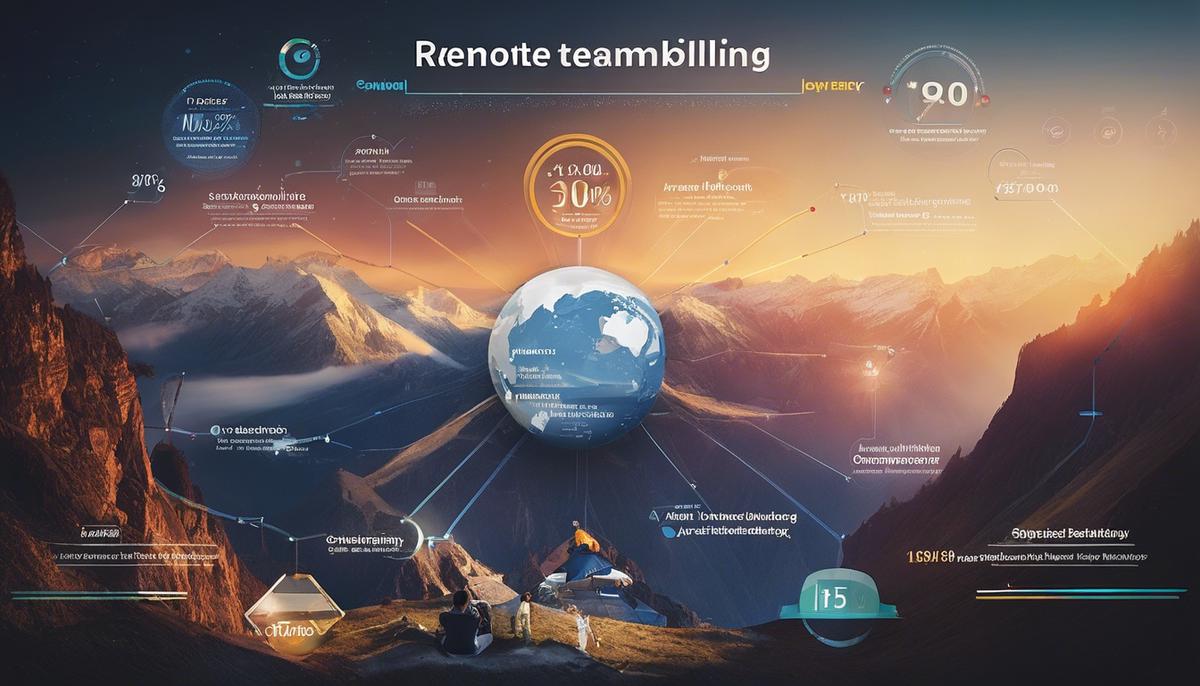As the world grows increasingly interconnected, the traditional workplace paradigm is experiencing a seismic shift towards remote work. This comparatively novel landscape, while presenting its unique set of benefits such as convenience and flexibility, also poses critical challenges, particularly in cultivating a productive and collaborative team culture. This exploration of the remote work environment will not only dissect its defining elements but will also shine a light on the critical aspects that drive successful team-building in a virtual setting. From the role of effective leadership and technology to the innovative team-building activities and benchmarks of success, we embark on this insightful journey to understand and master the fine art of fostering high-impact teams beyond geographical confines.
Table of Contents
1. Defining the Remote Work Environment
In an ever-evolving business landscape, managing remote teams poses unique challenges and brilliant opportunities. Technological leaps have made it possible for geographical barriers to crumble, permitting businesses, now more than ever, to acquire talent from across the globe. However, this newfound accessibility comes with its own set of challenges.
The current state of remote work is a sea of difficulties navigated swiftly by the entrepreneurial mariner. Amid shimmering seas of opportunities lurk hidden reefs of isolation, motivation drain, and communication breakdown. The savvy entrepreneur harnesses innovative strategies to not just survive but thrive in this elusive ecosystem.
One of the plight points haunting remote teams is isolation. Being physically distant from colleagues can lead to a perceived or real sense of isolation. To counteract this menace, businesses must create an environment that encourages engagement and inclusion. Innovative tech tools like Slack and Zoom empower us with digital gathering spaces. By embracing these tools, and combining them with strategies like virtual team-building exercises and daily check-ins, entrepreneurs foster a sense of camaraderie, pulling team members from the depths of isolation into the vibrant ebb and flow of a dynamic team.
The second hurdle is the issue of motivation. When employees work remotely, the line between personal and professional life often blurs. The kitchen becomes the office and the family room transforms into a conference room. In this milieu, motivation tends to wane. The solution? Fostering an environment that champions work-life balance. Motivation may be boosted by offering flex-time, encouraging regular breaks, and discouraging after-hours emails.
The third challenge, communication, is perhaps the most potent. Information that would be simple to pass along in person suddenly becomes an obstacle in a remote work environment. Fortunately, the solution lies within grasp, harmoniously twining innovation with simplicity. The incisive entrepreneur harnesses progressive technology and combines it with established cooperation principles. Apps like Asana or Basecamp streamline processes, ensuring tasks get completed without allowing communication to get lost in the cyber void.
Overcoming these challenges promises not just survival but successful evolution in this new business environment. By acknowledging the unique challenges of remote work and tackling them head-on with innovative strategies, an entrepreneur can create an invigorating workspace that is both productive and satisfying. With the right mindset and tools, the intrepid entrepreneur shall not just survive but, indeed, shall thrive in this brave new world of remote work. As the future unfolds, it is clear that remote work will not just be an option, but a linchpin that revolutionizes how business is conducted.

2. Team Building Essentials
Harnessing the Power of Remote Team Building: Essential Factors and Strategies
In the next evolutionary step for business, we are witnessing a dynamic shift towards remote work models. As pioneers within this new space, it is imperative to recognize the key factors necessary for effective team building in remote settings. After understanding the present state of remote work, associated challenges, and strategies to address isolation, motivation, work-life balance, and communication, it is important to further delve into the realms of training, culture, trust, and technology.
Despite geographical distances, training should never be a compromise. Continuous skills development, both job specific and general, should be seen as an integral part of the remote work culture. This means investing in online training platforms and webinars that propagate growth and adaptability within the workforce. Training not only equips employees with improved skill sets but also contributes to an integrated team vision.
Culture becomes a paramount factor in the remote work landscape. With diverse cultures, backgrounds, and time zones in the mix, it’s important to establish a universal organizational culture. This could be achieved through consistent team activities, virtual meet-ups, celebrating team wins; virtually anything that fosters a shared sense and understanding of identity.
Trust, the invisible glue holding any team together, is even more vital in the remote set up. The onus of cultivating a culture of trust falls upon the leadership. Transparency in decision making, open door policy, providing autonomous control, and conflict resolution are some tactics to enhance trust among team members.
Technology, our new-age ally, cannot be overlooked in effective team building. Invest in technology that bridges communication gaps and fosters collaboration. Project management tools, efficient virtual meeting platforms, and secure communication channels, to name a few, should form the basic tech stack of any remote team. Also, give heed to the individual technological needs of your employees to ensure they’re well-equipped for their respective tasks.
Furthermore, equip leaders to manage remote teams effectively. Leadership training for remote management should be prioritized to adapt to the unique challenges that come with leading from afar. Leaders should be a beacon of guidance, fostering team interaction and collaboration even with miles in between.
Lasty, embrace flexibility. Given the fluid nature of remote work, predictability becomes a luxury. Therefore, having flexible work structures, adopting a results-oriented approach rather than hours clocked in, and giving employees the liberty to carve their own work schedules, enhances productivity and team cohesion.
In essence, effective remote team building is not an impossible task, it just calls for innovative strategies and acceptance of a new work culture. The future of remote work is all set to redefine the contours of global business. Let’s embrace it with open minds, and fully unleashed potentials. By incorporating these elements within your remote work model, you are bound to achieve a dramatically enhanced team cohesiveness, despite the physical distances.
3. Innovating Remote Team Building Activities
Innovative Techniques for Enhancing Team Building in a Remote Work Environment
If you are searching for fresh strategies to galvanize your remote team, then you’ve landed in the right place. With the persistent evolution of business structures, the need for innovative, effective, and engaging remote team building techniques has become critical.
The Power of Collaboration Platforms
In this digital age, technology provides us with opportunities for real-time collaboration, and tapping into this space is key for successful remote team building. There are now a plethora of platforms, from Trello and Wrike to Slack and Microsoft Teams, that enhance the interaction, engagement, and productivity of remote teams. They simulate a virtual office environment where individuals can communicate, share files, and manage projects seamlessly. This can dramatically reduce disconnect and instill a sense of collective workforce synergy.
Maximizing Virtual Team Building Activities
Fun is serious business when it comes to team building. Interactive virtual games, virtual escape rooms, online quizzes, and video conference party games go a long way in fostering camaraderie and bolstering team spirit. These enjoyable moments can reinforce the personal ties that boost professional collaboration and productivity.
Leveraging Professional Development Opportunities
Using remote work as an opportunity to polish skills and expand knowledge can result in a high-performing, motivated team. Offering e-learning resources, virtual workshops, online training programs, and even MOOCs (Massive Open Online Courses) allows teams to learn collaboratively and grow professionally, while simultaneously feeling motivated and appreciated.
Submerging into Virtual Reality
We know this sounds futuristic, but imagine the power of virtual reality in breaking down the barriers of physical distance. VR presents untapped opportunities for fostering team unity and engagement. From virtual office tours to collaborative problem-solving scenarios, VR can provide an immersive team-building experience that bridges the geographical gap.
Emphasizing Recognition and Encouragement
Never underestimate the power of recognition. Virtual high-fives, employee of the month sections on your website, or even simple acknowledgements in team meetings can significantly uplift morale and incentivize top-quality work. Creating a culture where achievements, no matter how small, are consistently recognized breeds a sense of purpose and belonging among remote employees.
Conclusion
In an ever-progressing world where remote work structures are continually gaining traction, it’s essential for organizations to stay ahead of the curve. As the landscape of work evolves, so should our strategies and techniques for building a cohesive, engaged, and productive remote team. It’s not about just surviving, but thriving, and using innovation to overcome the prevailing challenges is the key to unleashing the full potential of remote teams.

4. Evaluating Team Building Success
Across the spectrum of thriving industries and professional communities, the ability to accurately measure the success of remote team building efforts has become an imperative need. From tech startups to traditional corporations, the pursuit of effective remote team building strategies and gauging their success has emerged as a key pivot towards organizational success.
An essential metric of successful remote team building is the overall productivity of the team. Are projects being accomplished on time? Are targets being met? Higher productivity typically mirrors effective team building and healthy co-operation. Concrete data, like sales figures or time taken to complete projects can serve as quantifiable measurements of success.
Employee engagement is another critical measure of effective remote team building. Engaged employees deliver a higher quality of work and are more inclined to the business’s overall objectives. Tools like pulse surveys, employee Net Promoter Scores (eNPS), and virtual feedback sessions can help measure levels of engagement.
While employee productivity and engagement are critical, organizations are quickly realizing the value of decentralization of decision-making as an indicator of successful team building. Allowing team members to take ownership and make decisions fosters an environment of trust and cooperation.
Tracking tool usage and adoption rates within a remote team, such as collaboration platforms or project management software, can reveal valuable information about team building success. Higher usage rates generally refer to more collaboration and progress.
Employee retention is another quintessential way to measure the success of remote team building efforts. High turnover could hint toward an inadequate remote culture or lacking team connections, while retention suggests the opposite: a team united and invested in one another and the organization.
The success of team building activities can also be gauged through direct feedback. Anonymous employee surveys regarding the impact and effectiveness of virtual team building activities can offer clear insights into what is working and what needs improvement.
Finally, a lesser-known but equally important metric is the ability to cultivate a universal organizational culture within diverse remote teams. A strong team culture, that transcends oceans and time zones, can unite members and foster innovation, creativity and shared achievements.
In conclusion, measuring the success of remote team building efforts is as complex as it is necessary. While productivity, engagement, and retention are critical, so too is cultivating a strong culture and fostering a sense of ownership among team members. Continuous feedback and innovation, powered by technology are central to refining and optimizing remote team building methodologies for continued business success. Be sure to keep your finger on the pulse of these metrics, as they are the compass guiding toward a future proofed, highly adaptive remote workforce.

As the dawn of a new era in work culture takes hold, it is clear that the future of work is flexible and remote. The challenges posed by distance, time and differences in physical presence all demand innovative solutions that sustain team cohesion and foster a productive environment. However, with careful planning, regular monitoring, and robust communication, these obstacles can be effectively mitigated. The outcomes, highlighted by improved productivity, fulfilled employees, and a stronger team spirit, are worth the commitment to building and nurturing remote teams. The landscape may be unchartered, but the potential rewards of successful remote team building are vast, opening new horizons for organizations ready to embrace the shift.

Matt Smith is a seasoned journalist and author whose expertise spans across the dynamic realms of Politics, Gadgets, Gaming, and a plethora of general interest topics. With a Master’s in Political science and tech pedigree shaped in Silicon Valley, Matt brings a wealth of knowledge and a critical eye to everything he writes.
Politics: Matt offers sharp political commentary, drawing from his experience as a political analyst and his academic rigor.
Gadgets: His tech insights are grounded in real-world experience, having been on the front lines of innovation with a degree from Caltech.
Gaming: A respected voice in gaming, Matt’s reviews and trend analyses are a testament to his deep involvement in the gaming community.
General Topics: From science to culture, Matt’s writing spans a broad spectrum, engaging readers with a blend of expertise and relatable prose.
Engage with Matt’s compelling content for a fresh perspective on the issues at the forefront of today’s discourse.

